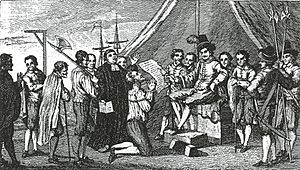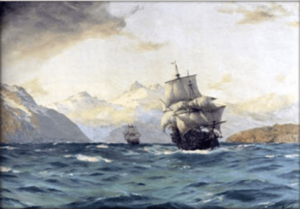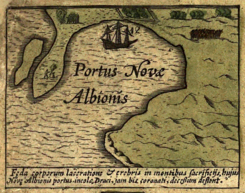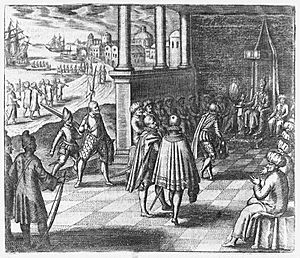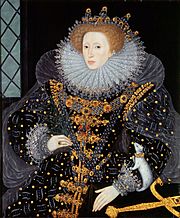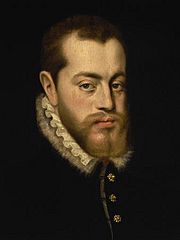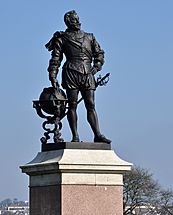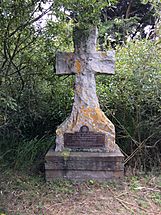Francis Drake's circumnavigation facts for kids
Quick facts for kids Francis Drake's circumnavigation |
|||||||
|---|---|---|---|---|---|---|---|
| Part of the Anglo–Spanish War | |||||||
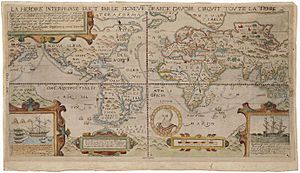 Engraved world map of Drake's circumnavigation |
|||||||
|
|||||||
| Belligerents | |||||||
| Commanders and leaders | |||||||
| Strength | |||||||
| Various ports & shipping | 5 ships 169 men and boys |
||||||
| Casualties and losses | |||||||
| 13 ships captured & plundered 12 merchants ships run aground 5 settlements plundered |
1 ship lost 2 ships scuttled 103 dead |
||||||
Francis Drake's circumnavigation was an amazing sea journey that happened between December 15, 1577, and September 26, 1580. Queen Elizabeth I of England secretly approved this trip. It involved five ships led by Francis Drake. While it was called a "voyage of discovery," it was actually a secret mission to raid Spanish ships and towns. This journey marked the beginning of England's challenge to Spain and Portugal's control over the world's oceans.
Drake started his voyage on December 15, 1577. After crossing the Atlantic Ocean and capturing some Spanish and Portuguese ships, he sailed around Cape Horn. He became the first Englishman to go through the Straits of Magellan. In October 1578, he reached the Pacific Ocean and sailed up the west coast of South America. Due to storms and sickness, only two ships were left, one of which was the famous Golden Hind.
Drake then attacked Spanish ports and captured many Spanish treasure ships. One of these was the very rich galleon Nuestra Señora de la Concepción. He continued sailing north, hoping to find a way back to the Atlantic. Drake went further up the west coast of America than any European before him. He landed in what is now California, claimed the land for England, and named it New Albion.
Since he couldn't find a passage back to the Atlantic, Drake turned south in the Golden Hind. In July 1579, he sailed west across the Pacific Ocean. His journey took him to the Moluccas, Celebes, and Java. Then he went around the Cape of Good Hope and finally the western tip of Africa. Drake returned to England in September 1580 with a huge amount of spices and treasure. He was the second person ever to sail around the world and the first Englishman to do it.
Seven months later, Queen Elizabeth made him a knight aboard the Golden Hind. This made King Philip II of Spain very angry because of Drake's pirate-like actions. Drake's voyage was one of the main reasons for the Anglo–Spanish War that started a few years later. Drake's entry into the Pacific, which Spain considered its private ocean, led Spain to try and block access to the Pacific at the Strait of Magellan.
Contents
Why the Voyage Happened

During the early days of exploration, the Treaty of Tordesillas divided the newly discovered lands between Spain and Portugal. The Pope approved this treaty. However, the Protestant Reformation in Europe meant that Protestant countries, like England, did not accept the Pope's authority. So, they didn't recognize the treaty.
In the 1560s, relations between King Philip II of Spain and Queen Elizabeth I of England got worse. This was partly because Elizabeth brought back royal control over the Church of England.
English traders and adventurers then tried to trade with Spanish settlements in the New World. Spain was very suspicious of any foreign country trying to trade or set up colonies in their controlled areas.
In 1567, an English privateer named Sir John Hawkins led a voyage to trade enslaved Africans in the Americas. Sir Francis Drake, Hawkins's cousin, joined him. Many ships were lost when a Spanish fleet attacked them at the Battle of San Juan de Ulua. Because of this, Spain became Drake's enemy for life, and they saw him as a pirate.
Drake later made two profitable trading trips to the West Indies in 1572. He commanded two ships and raided Spanish ports in the Caribbean. He saw the Pacific Ocean and captured the port of Nombre de Dios. He returned to England with Spanish treasure. Drake had to keep a low profile for a few years. But he planned another expedition, knowing he could get support. With a lot of stolen treasure hidden, Drake had enough money to prepare a new fleet. He also started building a strong, well-armed ship for his next journey.
Getting Ready for the Trip
In 1577, Queen Elizabeth I secretly asked Drake to lead an expedition against Spanish colonies on the Pacific coast of America. The Queen invested money in the trip, making Drake a privateer. The expedition also aimed to find places where England could set up new settlements.
Elizabeth and her court, including important people like Robert Dudley and Francis Walsingham, secretly supported Drake's privateering. This meant they supported him in looting Spanish ships and ports.
Drake spent the year getting his fleet ready. His main ship, which he had finished building, was the Pelican. It was designed like the nao Victoria, the first ship to sail around the world. The Pelican was 150 tons and had eighteen guns, making it the strongest ship of the expedition. Four other ships joined: the Elizabeth, the Marigold, and two supply ships, the Benedict and the Swan. In total, about 164 men joined the voyage.
An important crew member was Diego, a formerly enslaved African who had joined Drake in 1572. Diego was a free man and a skilled shipbuilder. He also spoke Spanish and English, which made him a valuable interpreter when Spanish or Portuguese people were captured. He helped Drake with local knowledge and even helped Drake trick the Spanish with false information.
There were also "gentlemen" adventurers on board, connected to the investors. One was Thomas Doughty, who had been with Drake before. Tensions grew between them. Drake's younger brother Thomas and his cousin John also joined. The crew included carpenters, a blacksmith, a botanist, and musicians. Walsingham also sent his chaplain, Francis Fletcher, to observe.
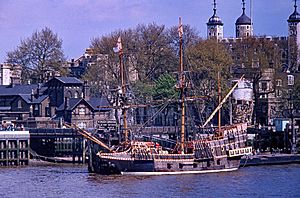
Drake used the best maps available at the time, like the one by Abraham Ortelius. To keep his real plans secret, Drake told his crew they were going on a trading trip to the Levant. This was to convince them to join and to hide the dangers they would face.
| Name | Captain | Crew | Weight (tons) | Fate |
|---|---|---|---|---|
| Pelican (Golden Hind) | Francis Drake | 80 | 160 | Completed voyage |
| Elizabeth | John Wynter | 45 | 80 | Left the fleet off Cape Horn and returned home. |
| Marigold | John Thomas | 25 | 30 | Lost with all hands off Cape Horn |
| Benedict (supply) | Thomas Moon | Exchanged for Christopher | ||
| Swan (supply) | John Chester | Scuttled (sunk on purpose) |
Drake and his fleet left Plymouth on November 15, 1577. But a storm in the English channel damaged the Pelican and Marigold. They had to go back to Plymouth for repairs, which took almost a month.
They finally left Plymouth on December 13, heading south into the Atlantic. Two weeks later, they reached Mogador off Morocco. While building a small boat there, Drake lost a man to local raiders. Sailing again, they passed the Canary Islands and captured three Spanish fishing boats and three Portuguese ships. Drake swapped the Benedict for a bigger Spanish ship, which he renamed Christopher.
Crossing the Atlantic

In January 1578, Drake sailed to the Portuguese Cape Verde Islands looking for supplies. At Santiago island, he captured a Spanish merchant ship called Santa Maria. This ship was full of wine and other goods, and Drake renamed it Mary. Drake found useful Spanish maps on board. More importantly, he gained a Portuguese navigator named Nuno da Silva, who knew a lot about sailing in South American waters and was willing to help.
Drake took command of the Mary and put Doughty in charge of his main ship, the Pelican. Later, tensions grew between Drake and Doughty. Doughty accused Drake's brother, Thomas, of stealing from the captured wine.
During the long Atlantic crossing, Drake's anger towards Doughty grew. Drake eventually moved Doughty to command the Swan. Doughty was very upset by this and started complaining about Drake.
Sailing Around South America
After passing the coast of Portuguese Brazil, Drake's fleet faced severe storms. On May 13, Drake anchored in a bay off Cape Tres Puntas. Another storm hit, forcing the ships back out to sea. When the Swan got separated, Drake became convinced that Doughty was using witchcraft. This idea spread among the crew.
On May 17, the fleet anchored at Deseado to wait for the other ships. The Swan arrived the next day. Drake was furious and again accused Doughty of witchcraft, which Doughty strongly denied. Drake decided to reduce his fleet because of losses from sickness and storms. They decided to sink the Swan, which angered Doughty even more. He confronted Drake, who lost his temper, hit Doughty, and had him tied to the mast. The captured Spanish ship Christopher was also burned, and only its useful parts were kept.
The Trial of Thomas Doughty
By June 3, Doughty and his brother, John, were put under house arrest. Sailors were forbidden from talking to them. Drake accused Doughty of being a "conjurer and a seditious person."
The English landed at San Julian in Patagonia. Fifty years earlier, Ferdinand Magellan had executed mutineers there. Drake's men saw old skeletons hanging from Spanish gibbets. They decided to stay in San Julian for the winter before trying to pass through the Strait of Magellan.
In San Julian, Drake decided to try Doughty for treason and trying to cause a mutiny. The main evidence against Doughty came from the ship's carpenter, Edward Bright. Doughty also admitted telling Lord Burghley, who didn't want to anger Spain, about the voyage's true purpose.
Doughty was found guilty of mutiny. On July 2, Drake insisted that Doughty be beheaded. This harsh example did not immediately stop the problems. Tensions between the sailors and the gentlemen explorers continued, almost leading to a mutiny for nearly a month. Drake then gave a powerful speech, setting clear rules and stating he was in sole command. After this, no one dared to think of mutiny again.
After trying to repair the Mary, they found its wood was rotting. So, they broke the ship apart for parts. In August, they sailed west to pass through the Strait of Magellan.
Through the Strait of Magellan
Before entering the Strait, in July 1578, Drake sent Wynter ashore. There, he learned from local people about a tree bark they ate. Captain Wynter collected a lot of this bark, which is why it's now called Winter's bark. On August 20, 1578, Drake renamed the Pelican to the Golden Hind. This was to honor his supporter, Sir Christopher Hatton, whose family symbol was a golden hind (a female red deer).
Drake passed through the Strait of Magellan in just 16 days. As soon as they entered the Pacific Ocean, violent storms nearly destroyed the remaining ships. The Marigold was lost with all hands and never seen again. A week later, the Elizabeth got separated from the Golden Hind. It was so badly damaged that the crew demanded to go home. Wynter, hoping to meet the other ships, wanted to sail to the East Indies. But fearing a full mutiny, he reluctantly headed back to England.
Now, only the Golden Hind remained, with less than half of the original 170 men. Drake sailed to Tierra Del Fuego and landed on one of its islands. In the Magellan Strait, Drake and his men fought with local people. They were the first Europeans to kill native people in southern Patagonia.
After this passage, the Golden Hind was pushed south. Drake discovered an island he named Elizabeth Island. Drake likely reached a latitude of 55°S along the Chilean coast. It's unlikely he reached Cape Horn itself, as his descriptions don't match, and his crew denied seeing an open sea there.
Mocha Island and the Mapuche People
The Golden Hind sailed north along the Pacific coast of South America. Their first stop was Mocha Island to get food and water. They met the native Mapuche people and had friendly interactions at first. On the first day, the Mapuche brought sheep, chickens, and wheat to the crew. On the second day, an eleven-man boat went ashore for water. But the Mapuche attacked them, killing two men and capturing two more. Several were wounded, including Diego and Drake, who both had many arrow wounds. Drake had one in his face. They left, but the two captured men were killed.
Diego never fully recovered from his wounds. A year later, near the Moluccas, he died, possibly from an infection. Drake regretted losing his servant, who was skilled and knew a lot about South America.
Raids on the Spanish West Coast
Heading further north, Drake recovered from his wounds. He spent weeks looking for settlements to raid.
Valparaíso and Callao
On December 5, Drake saw the small Spanish town of Valparaíso. He attacked the town and took valuable art and church silver. Its harbor held a ship that was even more valuable. It was full of Chilean wine, gold, and maps of the South American coast. Drake's attack on Valparaíso led to the legend of Cueva del Pirata.
Drake left and continued north along the coast. He sailed into Salada Bay near Copiapó. There, he repaired his ship and put together the Golden Hind's small boat. Drake waited for the Elizabeth to appear, which would have given him enough strength to attack Panama. When it was clear the Elizabeth wasn't coming, Drake sailed off.
Just before reaching Callao, Drake captured a Spanish ship. From the prisoners, he learned that many treasure ships were in the area. So, Drake entered Callao, the harbor for Lima, on February 13. The English easily took the town. In the harbor, Drake ordered a dozen ships to be searched and then sunk. They questioned the people and learned that a large treasure ship, Nuestra Señora de la Concepción, had recently left for Panama. It was carrying valuable silver. The next day, Drake quickly set off in pursuit with his small boat.
Spanish Chase

Around the same time, Spanish officials started getting reports that an English naval force was off the coast. Panic spread when news of raided settlements arrived. In Lima, the Viceroy of Peru Francisco de Toledo was shocked that the English had come so far. He immediately ordered all ships in Callao to be repaired and sent to chase Drake. However, none were ready to fight the Golden Hind.
Toledo sent a message to Lima for more troops. Two ships were chosen for the chase, but they were not properly balanced and returned to port. Toledo furiously ordered his own son, Luis, to lead an expedition with two heavily armed ships and eleven other vessels. They were to capture any English ship they found. They also had the best pilots, including Pedro Sarmiento de Gamboa, and 120 soldiers.
The Spanish fleet left Callao on February 27. They thought Drake was heading towards Panama.
Drake was still chasing the Nuestra Señora de la Concepción. He didn't know about the large Spanish force coming for him. He captured a small ship that had just left the Guayas River. This ship contained gold from the Zaruma gold mines.
Capturing Spanish Treasure Ships
On March 1, Drake saw the Nuestra Señora de la Concepción off the coast. Drake approached the slower ship. The Spanish captain, Juan de Anton, was surprised to see a foreign vessel. Drake ordered Diego to demand in Spanish that they lower their sails. Anton refused, so Drake fired cannons and guns. More cannons were fired, damaging the Spanish ship's rigging. Then, with the Golden Hind on one side and the small boat on the other, the English boarded the ship. The Spanish crew was completely surprised and surrendered quickly. Once they controlled the ship, Drake took both vessels to a quiet coastline to unload the treasure.
There was so much treasure that it took six days to unload it. Aboard the Nuestra Señora de la Concepción, Drake found many chests full of silver and gold. The total treasure was worth a huge amount of money. There was so much silver that it replaced the Golden Hind's ballast (weight to keep the ship stable). The crew was overjoyed. Drake was also pleased and dined with the Spanish officers. He released his captives later, giving them gifts and a letter of safe passage. Through Diego, Drake tricked the Spanish by saying there were other English ships in the area. This caused panic and confusion among the Spanish.
On March 16, Luis de Toledo and Gamboa sailed into Manta to get information on Drake. They learned about Drake's chase of the Nuestra Señora de la Concepción. They realized Drake had captured the ship. Gamboa thought he could cut Drake off before he reached the coast of Nicaragua. However, Don Luis decided to go to Panama to deliver his father's report about the English discovery of Spanish settlements.
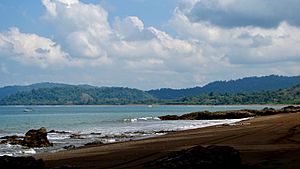
Meanwhile, Drake went further north along the South American coast. Near Cano island, Drake captured a ship carrying corn, honey, and sarsaparilla. Drake took the ship to a nearby bay (Bahía Drake). Here, the Golden Hind was repaired. Drake decided that the huge amount of treasure needed to be moved to lighten his ship. They moved some silver to the captured ship, which was strong. This ship was also armed with some of the Golden Hind's guns. Drake sent a group ashore to find water and food. They killed a crocodile and a monkey, which they brought back to the ships. This was the first time they had eaten meat in a while. At the same time, the English felt a "severe shake" even though they were a mile offshore. It was their first experience of a strong earthquake.
While the Golden Hind was being repaired, the small boat explored the area. It found another Spanish vessel, a small boat, which was captured with just one shot. Although it had little valuable cargo, the English captured two valuable maps that showed the Manilla-Acapulco route. Also on board were two Chinese pilots who knew the route across the Pacific. Drake then got rid of the sarsaparilla and set off in the last week of March, planning to raid the town of Guatulco.
Last Raids
Drake then raided the settlements of El Realejo and Sonsonate, finding little of value. At Guatulco, the English went ashore with little resistance and quickly looted the place. They found a heavy golden chain and silver. There were also plenty of supplies like water and food, which the crew badly needed. They also found fine China, silks, more maps of the Manilla galleon route, and some enslaved people. Drake stayed for a couple of days, then released all the Spanish captives. The Portuguese pilot Nuno da Silva was also released here. He was no longer useful as he knew little beyond the Magellan straits. He was told to give false information to the Spanish, saying Drake was heading home via the Northwest Passage. Guatulco was Drake's last raid on the West Coast of New Spain.
Nuno da Silva was later questioned by the Spanish. He gave the false information Drake wanted them to hear. However, the Spanish did not believe him. At the same time, the Spanish chase was going nowhere. Toledo decided to go to Panama, where the "pursuit" ended. Still, the Spanish continued to guard the routes where they thought Drake might turn around to head back through the Straits of Magellan.
California and the Pacific North West
Drake sailed north to find a shortcut back to England through the supposed Strait of Anián. This was a mythical passage believed to connect the Pacific and Atlantic oceans around 40 degrees north.
In May, Drake's two ships passed the Baja Peninsula and continued north. Before Drake's voyage, the western coast of North America had only been partly explored in 1542 by the Spanish explorer Juan Rodriguez Cabrillo. Drake wanted to avoid more conflict with Spain, so he sailed northwest, far from Spanish areas. He searched for a good bay to repair his ship for the journey back to England.
On June 5, 1579, the ship briefly landed at South Cove in Oregon. They gathered fresh water and food. Drake might have reached as high as 48 degrees north, but bad weather stopped his northward progress. Failing to find the strait, Drake turned back south.
Nova Albion

On June 17, as Drake headed south, his crew found a protected cove and landed on the coast of what is now Northern California. After staying there for twelve days, Drake set off again and landed somewhere north of Spain's northernmost claim at Point Reyes. He found a good bay, an estuary known as Drakes Estero. After setting up a small wooden fort and tents ashore, the crew restocked the two ships. They stayed for a while to repair and clean the ships.
Drake also met the Native Coast Miwok people. They soon had friendly interactions, exchanging gifts. The English were given food. In a special moment, a large group of Coast Miwok came to the camp. They honored Drake by placing chains around his neck, a scepter in his hand, and a crown of feathers on his head, as if making him king. Based on this, England claimed the territory. Drake named the land Nova Albion (Latin for "New Britain") for the English Crown and Queen Elizabeth I. He chose this name because the white cliffs he saw looked like those in England, and "Albion" was an old name for Great Britain. To show his claim, Drake is said to have attached an engraved brass plate, with Elizabeth's image, to a large post. This plate claimed the land for Elizabeth and future English monarchs.
After gaining the Coast Miwok's trust, Drake explored the inland area and visited their villages. Francis Fletcher observed and wrote in detail about the wildlife, countryside, and climate. He also wrote in great detail about the Coast Miwoks themselves. This was the first written record of any of the 64 different language groups in prehistoric California.
After several weeks on this coast, the English were ready to leave. They left the Spanish ship behind in the bay. Overall, relations between the Coast Miwok and their visitors were peaceful and friendly. When Drake and the crew left New Albion on July 23, the Miwok seemed sad as the Golden Hind sailed away.
Drake paused his journey the next day, anchoring at the Farallon Islands. The crew hunted seal meat there.
-
Detail of Jodocus Hondius map of 1589 showing cove in New Albion visited by Francis Drake.
-
Drake's landing in California, engraving published 1590 by Theodor de Bry
Pacific and East Indies
On July 23, the Golden Hind left New Albion. Two days later, they sailed west to continue their Pacific crossing. Good winds carried the ship southwest to the Caroline Islands by October 13, a very quick passage. After staying at either Yap or Palau for two days, they faced some hostility from hundreds of natives in canoes. Fearing they would be overwhelmed, the English fired shots, killing or wounding about twenty people, before sailing off.
A week later, a Portuguese ship was sighted. Drake tried to capture it, but the ship moved into shallow waters. Drake, with his ship heavily loaded, didn't dare to follow for fear of getting stuck. So he turned away and continued west.
Moluccas and Celebes
Drake soon reached the Moluccas, known as the 'Spice Islands' for their rich plantations of nutmeg and cloves. Drake was careful about meeting Portuguese trading settlements. Luckily, by mid-1575, most Portuguese positions in the Moluccas had fallen to the native islanders.
In early November 1579, Drake met two fishing canoes near Siau Island. They guided the Golden Hind through the islands to Ternate. There, Drake was welcomed by Sultan Babullah in an old Portuguese castle. The Sultan controlled many islands and traded mostly in cloves. Drake said he was no friend of the Portuguese and wanted to trade for spices.
After talks, Babullah sent Drake and his men a feast of rice, chicken, fruit, and other foods. Drake was impressed with Babullah. He traded English linen, gold, and silver for about ten tons of exotic spices, mostly cloves. With so many valuable cloves, Drake rewarded his crew with silver, which boosted their spirits. The Golden Hind stayed for five more days before sailing away.
Drake looked for a place to repair and resupply his ship. He soon arrived off the Celebes islands. Unaware of dangerous shallow areas, his ship got stuck on a reef on January 8, 1580. Here, Fletcher argued with Drake. Fletcher suggested that their ship's trouble was because of Doughty's execution. Drake disagreed. After the sermon, Drake had Fletcher chained up and "excommunicated" him. The sailors waited for the right tides. They dumped three tons of cargo (mostly cloves) and some guns. After three days, the ship finally broke free, much to everyone's relief. As they left, they were pushed southeast into the Banda Sea. They stopped at either Damer or Romang island to repair the Golden Hind.
Java
The next month was difficult for Drake. Bad weather and confusing seas in the East Indies made sailing tough. They slowly made their way west into the Savu Sea, passing the northern coast of Timor. On March 11, they finally landed at Tjilatjap on Java, anchoring safely away from land. A boat of armed men went ashore and were welcomed by the locals. The locals showed them where to find water and food. Drake then met with the local leaders and began trading. They wanted the finest silks, which Drake had plenty of from his raids. They stayed for two weeks and gathered enough supplies like rice, chickens, yams, and dried beef for part of the journey back. Drake was the first European to sail along Java's southern shores, proving that Java was an island and not part of a larger southern continent.
On March 24, Drake sailed off with a good wind and entered the Indian Ocean. He had about 11,000 miles to go before reaching England.
Indian Ocean to Plymouth
Drake had good winds and sailed without stopping to the southern tip of Africa. They rounded the Cape of Good Hope on June 15. They expected severe storms, but were surprised to find good weather and a steady wind. Sailing north, food and water became very scarce after sailing nearly 9,700 miles without stopping. Only one man was lost during this long stretch. As they continued north, they reached the western tip of West Africa (present-day Sierra Leone) and landed on July 22. They took on fresh water, fruit, and other supplies. Many crew members saw elephants for the first time. They also found an "oyster-tree" with many oysters on it. They repaired the ship, and two days later, left for the English Channel.
Drake and his crew had some worries as they neared England. They wondered if King Philip of Spain had declared war because of Drake's actions. They also worried if Mary Stuart had become Queen. Drake wanted to meet English merchant ships to get information before finally entering port.
Drake arrived in the English Channel on September 26. He soon met some fishermen and asked them about the Queen and if England was at peace. The fishermen told him all was well, but they were amazed to learn the captain was Drake. By this time, most people in England thought he and his men were lost, since John Wynter had returned alone with the Elizabeth a year earlier. The fishermen sailed into Plymouth with Drake and his 59 remaining crew members. They brought with them a rich cargo of spices and captured Spanish treasures.
After the Voyage
Drake became the first Englishman to sail around the world. He had raided or plundered six coastal towns. He captured thirteen ships, took their goods, used them, and then either released or sank them. He also ran aground twelve other ships in Callao.

Queen Elizabeth made Drake a knight aboard the Golden Hind in Deptford on April 4, 1581. A French diplomat performed the knighting. By involving the French, Elizabeth gained their support for Drake's actions. After becoming a knight, Drake adopted the coat of arms of an old Devon family.
The voyage brought a huge amount of money to England. The Queen declared that all written accounts of Drake's voyages were "Queen's secrets." Drake and others involved were sworn to secrecy, even facing death if they spoke. Elizabeth wanted to keep Drake's activities hidden from Spain. Drake gave the Queen a special jewel to remember the circumnavigation. It was made of gold and had an African diamond and a ship with an ebony hull. The Queen gave Drake a jewel with her portrait, a rare gift for a commoner. Drake proudly wore it in his 1591 portrait. This "Drake Jewel" is now in the Victoria and Albert Museum in London. All the investors, including Walsingham, were richly rewarded, getting back about 50 times what they invested.
Drake became incredibly rich. He was allowed to keep a large sum of the stolen treasure for himself and his crew. He was admired in England and became very powerful. He quickly became a favorite at the Queen's court. Drake became Mayor of Plymouth in September 1581 and then a member of parliament in 1581 and 1584. The execution of Doughty, however, continued to bother Drake.
Drake also had the Queen's permission to continue his privateering. The money from these raids helped fund the second half of Elizabeth's reign. England's government didn't have enough money to build a strong navy, but privateering helped by using armed ships and sailors.
The circumnavigation was also a huge success for England's image. The stories of sailors surviving dangerous waters and the lure of adventure were important. Thomas Cavendish, inspired by Drake's voyage, sailed around the world himself by 1588. Other explorations followed, leading to a period of British sea power and colonization that lasted for centuries.
Spanish Reaction
After Drake's successful voyage, Spain felt its colonies were vulnerable. Francisco de Toledo realized this weakness. He wanted to build forts on the coast for protection against foreign pirates. He also created "la Armada del Mar del Sur" (the Southern Fleet) in Callao. Most of the money, however, went to defenses and lookouts in the Strait of Magellan. To block the passage, Toledo sent a fleet under Pedro Sarmiento de Gamboa to explore and claim the region for Spain. They carefully explored the strait, looking for any English ships, but found none. They also looked for places to build forts. Gamboa then went to Spain to tell Philip II about the dangers of the sea route being open to his European enemies. Philip approved action, but an expedition in 1584 failed. Gamboa was captured by English privateers two years later.
The biggest impact of the voyage was on the relationship between Spain and Portugal. Drake's capture of the Nuestra Señora de la Concepción showed that Spain had been active in the Far East. This area was supposed to be Portugal's according to the 1494 Treaty of Tordesillas. This was one reason why Philip launched a Spanish invasion of Portugal, which led to the Iberian Union (Spain and Portugal being ruled by the same king).
Drake's two expeditions greatly angered Philip II. Relations between England and Spain continued to worsen, eventually leading to open war.
War with Spain
War between England and Spain officially began in 1585. The Queen ordered Drake to lead the next expedition to attack the Spanish New World as a preemptive strike (an attack to prevent a bigger attack). Drake sailed to the West Indies and in 1586 captured Santo Domingo and Cartagena de Indias. News of this reached Spain and encouraged Philip to invade England.
Philip's plan to send a huge fleet, the 'Armada', against England soon became known. Drake led another attack on Spanish ships being prepared in Cadiz in April 1587. Many ships were destroyed. This raid, which Drake called his 'Singeing the King of Spain's Beard', delayed the Armada for a year. This allowed the English to get ready their defenses. Drake was also a key leader during the Armada campaign. Drake's ability to attack England's Catholic enemies made him a hero at home. The Spanish called him 'El Draque' (The Dragon) and King Philip offered a large reward for anyone who could eliminate Drake.
Claiming Nova Albion
The exact location of the port in Nova Albion was kept secret from the Spanish. Some of Drake's maps might have been changed to hide it. All original records from the voyage, including logs and charts, were lost when Whitehall Palace burned in 1698. A bronze plaque, said to be Drake's claim to the new lands, was found in Marin County, California. However, it was later declared a hoax. Today, the officially recognized location of Drake's New Albion is Drakes Bay, California. Some historians believe Queen Elizabeth wanted to keep Drake's explorations secret, leading to hidden or changed reports. Still, many experts have suggested different places where Drake might have landed, from Alaska to northern Mexico.
The claim of Nova Albion was important for Britain for centuries. It helped strengthen Britain's right to trade furs along the Northwest Coast. Its influence was seen in the Nootka Crisis with Spain in 1789 and also in the 1846 Oregon Treaty, which extended the border of Canada along the 49th parallel to the Pacific.
Legacy
The voyage fascinated people like Gerardus Mercator, a mapmaker, who often talked with Abraham Ortelius about Drake's discovery of 'Nova Albion'. But the secrecy of Drake's voyage made it hard for them to get details.
The first detailed account of the voyage, The World Encompassed by Sir Francis Drake, was published in 1628. It was put together by Drake's nephew, using his uncle's journal, notes from Francis Fletcher, and other sources. For a long time, historians relied on vague accounts from Drake's navigator, Nuna da Silva, and John Wynter. It wasn't until 1909 that da Silva's detailed log was found in archives in Seville. This log gave historians the best look into Drake's voyage and life in the Elizabethan Navy.
For the 400th anniversary of the circumnavigation, a replica of the Golden Hind was built starting in 1973. It sailed from Plymouth in late 1974, arriving on May 8, 1975, in San Francisco. This was to remember Sir Francis Drake's claim of New Albion in California.
-
Statue commemorating Drake and his circumnavigation of the Globe in Plymouth Hoe
-
The stern of the "Golden Hinde" replica of the Golden Hind docked in Southwark
See also
- Magellan expedition
- Loaísa expedition
- Martín Ignacio de Loyola
- George Anson's voyage around the world
- Operation Drake
- Drimys winteri
- A Strange Discovery


